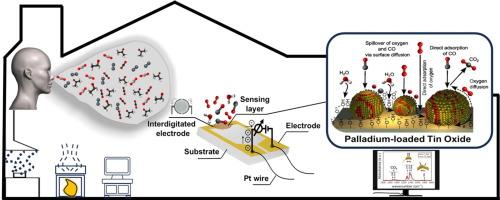负载钯的氧化锡纳米杂化物的化学气敏特性研究
IF 6.9
2区 材料科学
Q2 CHEMISTRY, PHYSICAL
引用次数: 0
摘要
采用易浸渍、原位还原、退火法制备了不同负载的原始氧化锡(SnO2)纳米复合材料和负载pd的SnO2纳米复合材料。采用x射线衍射、扫描电镜和透射电镜对样品的晶体结构和形貌进行了表征。x射线光电子能谱、拉曼光谱和ex-situ extended x射线吸收精细结构(EXAFS)证实PdO纳米团簇在SnO2表面稳定。结果表明,负载量为2.8 wt%的Pd/SnO2对CO的灵敏度高,检出限低,响应速度快,对CO干扰气体有良好的选择性。其传感性能的增强主要归功于PdO的精细结构、PdO与SnO2的协同作用以及不同的缺陷结构和浓度。现场FTIR测试揭示了反应条件下CO在Pd/SnO2上的吸附动力学,并在此基础上提出了一种可能的传感机理。也就是说,(100)和(111)面的边缘、台阶和台阶上的Pd和PdO为CO提供了有利的吸附和活化位点,活化的碎片从那里溢出到SnO2上,与离子吸附的氧发生反应,局部降低了耗尽层和传感器电阻;与此同时,碳相关的物种形成并分解成二氧化碳。本文章由计算机程序翻译,如有差异,请以英文原文为准。


Exploring characteristics of palladium-loaded tin (IV) oxide nanohybrids towards chemiresistive gas sensing
Nanocrystalline pristine and Pd-loaded tin (IV) oxide (SnO2) nanocomposites with different loadings were synthesized via facile impregnation and in-situ reduction, followed by annealing. The crystal structure and morphology of the samples were characterized by X-ray diffraction, scanning electron microscopy and transmission electron microscopy. X-ray photoelectron spectroscopy, Raman spectroscopy and ex-situ extended X-ray absorption fine structure (EXAFS) confirm PdO nanoclusters stabilized on SnO2 surface. Results revealed that Pd/SnO2 with 2.8 wt% loading exhibits the best sensing performance, including high sensitivity to CO with a low detection limit, fast response, and good selectivity to CO against interfering gases. Its enhanced sensing performance is attributed to both fine structure of PdO, and the synergy between PdO and SnO2 as well as dissimilar defect structures and concentrations. In-situ FTIR measurements unraveled CO adsorption kinetics on Pd/SnO2 under reaction conditions, based on which a possible sensing mechanism is put forth. Namely, Pd and PdO on edges, steps, and terraces of (100) and (111) facets provide favorable adsorption and activation sites for CO, from which activated fragments are spilled over onto SnO2 to react with ionosorbed oxygen, locally decreasing depletion layer and sensor resistance; and concurrently, carbon-related species are formed and decomposed into CO2.
求助全文
通过发布文献求助,成功后即可免费获取论文全文。
去求助
来源期刊

Applied Surface Science
工程技术-材料科学:膜
CiteScore
12.50
自引率
7.50%
发文量
3393
审稿时长
67 days
期刊介绍:
Applied Surface Science covers topics contributing to a better understanding of surfaces, interfaces, nanostructures and their applications. The journal is concerned with scientific research on the atomic and molecular level of material properties determined with specific surface analytical techniques and/or computational methods, as well as the processing of such structures.
 求助内容:
求助内容: 应助结果提醒方式:
应助结果提醒方式:


